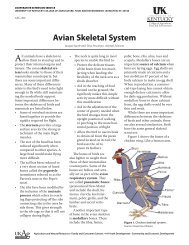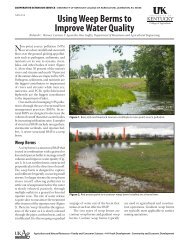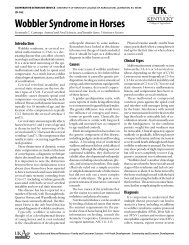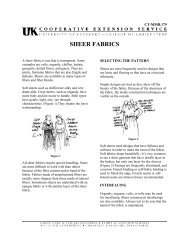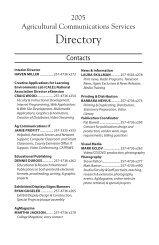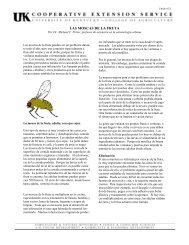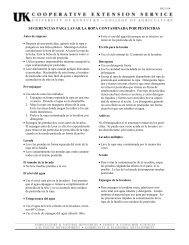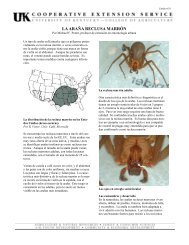Bias Strips – Single and Continuous - University of Kentucky
Bias Strips – Single and Continuous - University of Kentucky
Bias Strips – Single and Continuous - University of Kentucky
Create successful ePaper yourself
Turn your PDF publications into a flip-book with our unique Google optimized e-Paper software.
CT-MMB.723<br />
<strong>Bias</strong> <strong>Strips</strong> <strong>–</strong> <strong>Single</strong> <strong>and</strong> <strong>Continuous</strong><br />
<strong>Bias</strong> is a diagonal line <strong>of</strong> direction across a woven fabric. True bias is<br />
the direction on woven fabric that has the greatest amount <strong>of</strong> stretch.<br />
Because <strong>of</strong> this stretch, bias-cut strips are <strong>of</strong>ten used for bindings,<br />
tubing, <strong>and</strong> covering for cording. <strong>Bias</strong> strips can be made from<br />
fashion fabric or purchased as bias binding in a variety <strong>of</strong> colors<br />
<strong>and</strong> widths. <strong>Strips</strong> may be cut single or sew <strong>and</strong> cut continuous.<br />
True <strong>Bias</strong><br />
To cut single bias strips from fashion fabric, follow these steps:<br />
Figure 1<br />
• Locate the true bias by folding one end <strong>of</strong> the fabric so that the<br />
lengthwise yarns are lined up with the crosswise yarns; the diagonal fold line is the true bias.<br />
• Cut the fabric along the diagonal fold.<br />
• Draw lines parallel to the diagonal cut edge the desired width <strong>of</strong> the bias strip.<br />
• Cut along drawn lines. (Figure 1)<br />
To join single cut bias strips or when using pre-cut purchased bias strips, follow these steps:<br />
• Square <strong>of</strong>f the ends <strong>of</strong> the bias strip at a 90 degree angle with the bias edge.<br />
Both cut edges will be on the bias. (Figure 2)<br />
• To join the bias strips for a longer strip, place right sides<br />
together with one strip at a 90 degree angle to the other.<br />
Match corner to corner.<br />
• Draw the stitching line diagonally from corner to corner as<br />
illustrated. The stitching line will follow the straight grain.<br />
(Figure 3)<br />
Figure 2<br />
• Sew on the drawn line.<br />
• Trim fabric corners ¼-inch away from stitching line. (Figure 4)<br />
Figure 3 Figure 4<br />
<br />
• Press seam open. (Figure 5)<br />
Figure 5
Joining bias strips for binding can be done before strips are cut, saving time over joining individual<br />
cut strips. For continuous bias strips, select a fabric for your bias or binding <strong>and</strong> start by cutting a<br />
square <strong>of</strong> the fabric. A 22½-inch square will yield about six yards <strong>of</strong> 2¼-inch-wide bias strips. Cut<br />
the square once on the diagonal from one corner to the opposite corner. (Figure 6) You will now<br />
have two triangles.<br />
22 ½ inches <br />
¼ inch seam <br />
22 ½ <br />
inches <br />
Figure 6<br />
Figure 7<br />
With right sides together <strong>and</strong> matching lengthwise grain edges, sew the two triangles together with<br />
a ¼-inch seam allowance as illustrated in Figure 7. Press seam open.<br />
<br />
a<br />
b <br />
Figure 8<br />
Figure 9<br />
Mark lines every 2¼ inches on the wrong side <strong>of</strong> the fabric as shown in Figure 8.<br />
With right sides together, bring short ends together, matching point a to point b. These points are<br />
¼ inch from the cut edge on the marked lines. Sew edges together using a ¼-inch seam allowance.<br />
This creates an <strong>of</strong>fset tube that will enable you to cut one continuous bias strip. Begin cutting,<br />
following marked lines. (Figure 9)<br />
Marjorie M. Baker, M.S.<br />
Extension Associate for Clothing <strong>and</strong> Textiles<br />
April 2005. Revised May 2009<br />
Estimating the amount <strong>of</strong> bias you can cut from a square:<br />
Width <strong>of</strong> square X length <strong>of</strong> square = area <strong>of</strong> the square<br />
Area <strong>of</strong> the square / width <strong>of</strong> the bias strip = length <strong>of</strong> the continuous bias strip<br />
Estimating the size <strong>of</strong> the square, given the length <strong>of</strong> bias needed:<br />
Length <strong>of</strong> bias strip X width <strong>of</strong> the bias strip = area <strong>of</strong> the strip<br />
Square root <strong>of</strong> the area <strong>of</strong> the strip = size <strong>of</strong> the square<br />
Copyright © 2009 for materials developed by <strong>University</strong> <strong>of</strong> <strong>Kentucky</strong> Cooperative Extension. This publication may be reproduced in portions or its<br />
entirety for educational or nonpr<strong>of</strong>it purposes only. Permitted users shall give credit to the author(s) <strong>and</strong> include this copyright notice.<br />
Educational programs <strong>of</strong> <strong>Kentucky</strong> Cooperative Extension serve all people regardless <strong>of</strong> race, color, age, sex, religion, disability or national origin.<br />
2



